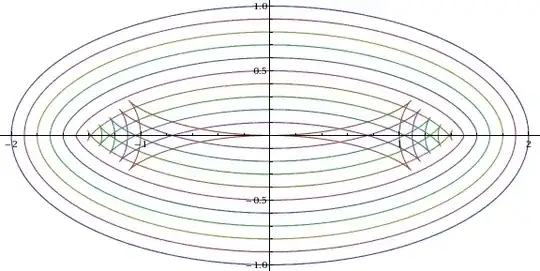Suppose I have a (physical) template, consisting of a piece of stiff sheet plastic with a hole cut in the middle. Suppose the hole is in the shape of an ellipse, say, 8 x 12 inches. Suppose I then use a router (rotary cutter) that has a circular collar that rides against the edge of the template (inside the hole) and which has a rotary bit (like a truncated drill bit) that is 1/2" smaller than the diameter of the collar (1/4" smaller than the radius of the collar) and centered within it. If I attach the template to a flat surface and then use the router to cut a hole in that surface, keeping the collar tight against the inside edge of the template, will the resulting hole in the surface still be an ellipse?
-
Your router looks something like this, right? – J. M. ain't a mathematician Sep 15 '11 at 17:51
-
A related question. – J. M. ain't a mathematician Sep 15 '11 at 17:58
-
@J.M. -- Yep, essentially that kind of router. A collar would be fastened either to the base or to the shaft of the bit to hold the bit a fixed distance from the template edge. – Daniel R Hicks Sep 15 '11 at 18:41
-
@J.M -- I can't believe that I screwed up the title that badly!! I generally check spelling/wording over pretty closely, but after fixing the second "elipse" => "ellipse" I didn't look for the first, and the extra "d" must have fallen from the sky. – Daniel R Hicks Sep 15 '11 at 18:47
-
No worries. :) It's fixed now, right? – J. M. ain't a mathematician Sep 15 '11 at 18:56
-
Related: Uniform thickness border around skewed ellipse? – Nov 19 '12 at 18:19
1 Answers
If I understand correctly your description (I probably don't: my English drilling-related vocabulary is pretty nil!) the resulting curve will be a parallel curve to the ellipse, which is not an ellipse.
In the following picture, the outer curve is an ellipse with semiaxes $2$ and $1$, and the curves inside it are parallel curves to it, at distances separated $\tfrac1{10}$.

Technically, if $\alpha:(a,b)\to\mathbb R^2$ is a unit-speed parametrization of your curve oriented so that it has positive curvature (that is, so that it curves to the left), with its tangent vector $\mathbf T=\alpha'$ and its normal vector $\mathbf N$ (uniquely determined by the condition that $\{\mathbf T,\mathbf N\}$ be a positively oriented orthonormal basis of $\mathbb R^2$), then the parallel curve $\beta_d$ to $\alpha$ at distance $d$ in the direction of $\mathbf N$ is the curve $$\beta_d(t)=\alpha(t)+d \mathbf N(t).$$
- 135,076
-
OK, thanks. I suspected as much, but my math is weak enough that I wasn't sure. And your diagram very nicely illustrates how it breaks down. – Daniel R Hicks Sep 15 '11 at 18:43